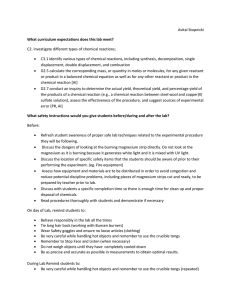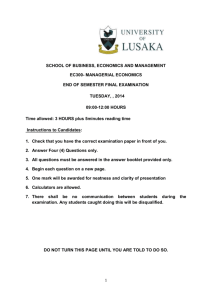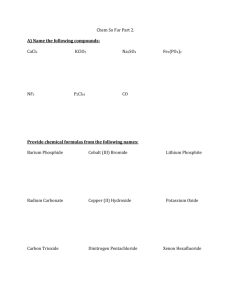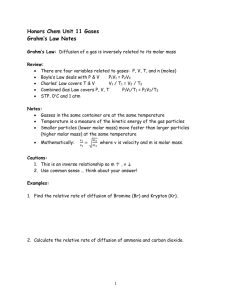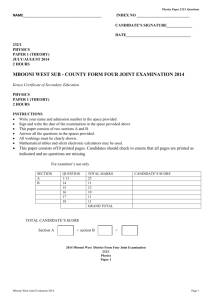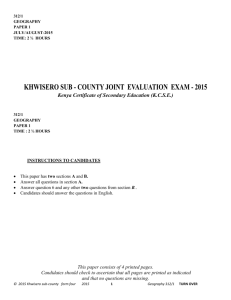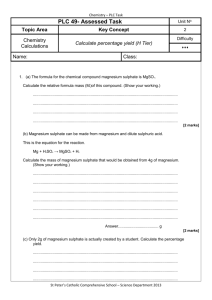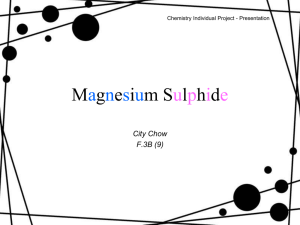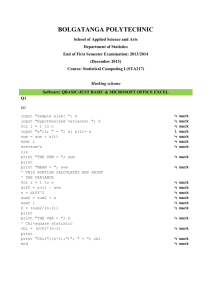Molar Volume of Hydrogen Lab: Chemistry Experiment
advertisement
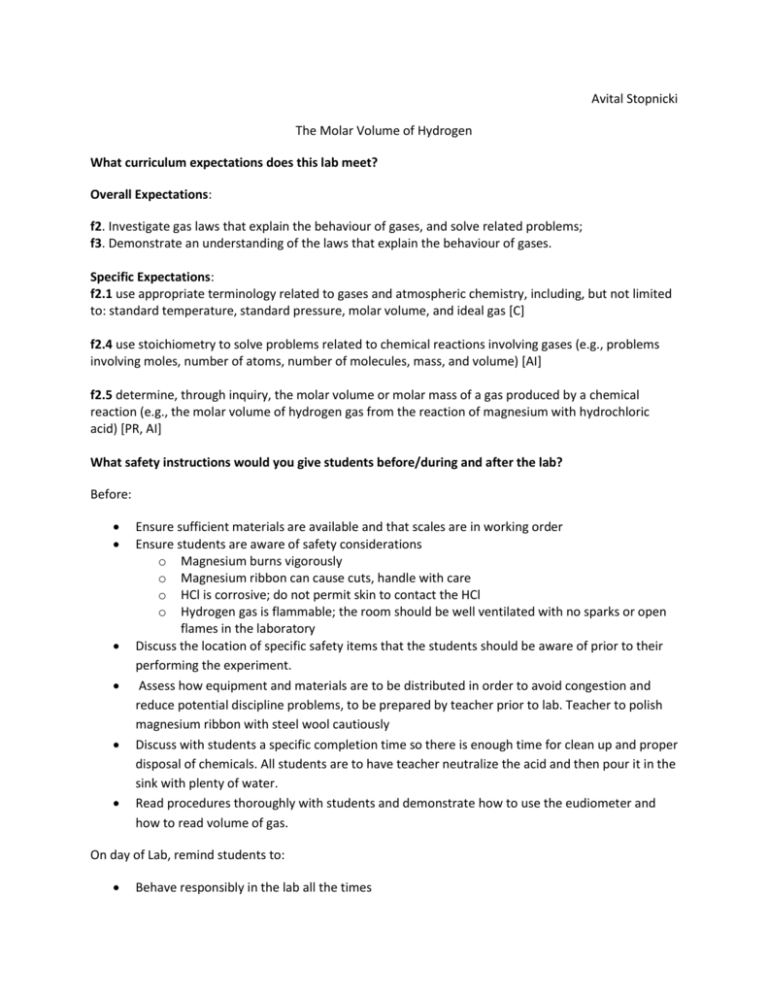
Avital Stopnicki The Molar Volume of Hydrogen What curriculum expectations does this lab meet? Overall Expectations: f2. Investigate gas laws that explain the behaviour of gases, and solve related problems; f3. Demonstrate an understanding of the laws that explain the behaviour of gases. Specific Expectations: f2.1 use appropriate terminology related to gases and atmospheric chemistry, including, but not limited to: standard temperature, standard pressure, molar volume, and ideal gas [C] f2.4 use stoichiometry to solve problems related to chemical reactions involving gases (e.g., problems involving moles, number of atoms, number of molecules, mass, and volume) [AI] f2.5 determine, through inquiry, the molar volume or molar mass of a gas produced by a chemical reaction (e.g., the molar volume of hydrogen gas from the reaction of magnesium with hydrochloric acid) [PR, AI] What safety instructions would you give students before/during and after the lab? Before: Ensure sufficient materials are available and that scales are in working order Ensure students are aware of safety considerations o Magnesium burns vigorously o Magnesium ribbon can cause cuts, handle with care o HCl is corrosive; do not permit skin to contact the HCl o Hydrogen gas is flammable; the room should be well ventilated with no sparks or open flames in the laboratory Discuss the location of specific safety items that the students should be aware of prior to their performing the experiment. Assess how equipment and materials are to be distributed in order to avoid congestion and reduce potential discipline problems, to be prepared by teacher prior to lab. Teacher to polish magnesium ribbon with steel wool cautiously Discuss with students a specific completion time so there is enough time for clean up and proper disposal of chemicals. All students are to have teacher neutralize the acid and then pour it in the sink with plenty of water. Read procedures thoroughly with students and demonstrate how to use the eudiometer and how to read volume of gas. On day of Lab, remind students to: Behave responsibly in the lab all the times Wear Safety goggles and rubber gloves Be very careful while handling acid Call teacher if acid spills Remember to Stop Face and Listen (when necessary) Be as precise and accurate as possible in volume readings. During Lab Remind students to: Safety is paramount when using strong acids Remember to wash with lots of water if acid spills and tell your teacher. If large spills occur, teacher will neutralize acid with baking soda and wash with lots of water What prior knowledge do you need to be able to lead the lab? Students must: Have learned about molar volume Have learned the law of partial pressures; PV = nRT Understand how to use this law in calculations Use the lab equipment as required for the lab (to be demonstrated by teacher) Key words for this lab: molar volume, mass-volume relationships, pressure, temperature, volume, partial pressure and STP. . What is the purpose of the lab? Is it to introduce a concept? Reinforce? Lab skills? etc. To determine the molar volume of hydrogen and to study the mass-volume relationships in chemical reactions. This lab helps students understand the quantitative relationships that define the ideal gas law, tying directly into one of the big ideas of the unit. This lab therefore serves to reinforce concepts learned and provide students an opportunity to put theory to practice. Students will also be testing their lab skills in proper use of materials and methodology, they will be using a eudiometer to collect and measure volume of a gas - which may be a new introduced skill - safety procedures, making observations (qualitative and quantitative analysis) and inferences (based on prior knowledge and pre-lab questions). How will you assess this lab? (Please make specific reference to KICA) I would assess this as a formal lab report, and collect the pre-lab prior to the experiment. LAB REPORT RUBRIC Lab Title: ___________________________ Due Date: _________________ Name: ________________ Lab Report Section � Level 1 � Level 2 � Level 3 � Level 4 Comment Hypothesis (TI) 0.5 1.0 1.5 2.0 (correctness, wording) Materials and (No extras, all present) Procedure C 0.5 1.0 Observations (Data Table) (C) (data table) 2.0 3.0 Flow Chart (question 9 pre-lab) (C) 1.0 2.0 Error Analysis (A) 0.5 1.0 Conclusions (assessment of 2.0 3.0 4.0 5.0 3.0 4.0 1.5 2.0 1.5 2.0 2.0 3.0 hypothesis, how well do results support expectations of purpose and design) (A) 0.5 1.0 General Format, Completeness, Neatness C 0.5 1.0 Pre-Lab Questions: 1 (KU 2marks) ______ 2 (KU 2marks) _______ 3 (KU 4marks) ______ 4 (TI 2marks) ______ 5 (KU 1mark) ______ 6 (KU 2marks) _______ 7 (TI 1mark) _______ 8 (TI 3marks) _______ Analysis Questions: 1 (A 2marks) _______ 2 (A 2marks) _______ 3 (A 2marks) _______ 4 (A 2marks) _______ 5 (A 2marks) _______ Total: KU: /11 TI: /8 A: /14 C: /15 How could you modify this lab for enriched students? students with IEPs? ELL? etc. For ELL and IEP: Providing a page of definitions can be the first step, making sure they understand all the terms used to describe procedures, simplify language for procedures, and provide procedures using images; eg. Match image with equipment. Provide more support during the pre-lab questions, prior to the lab to ensure they understand the purpose of the lab and all procedures (this can be done simultaneously for IEP`s as well). You might place ELL students strategically in lab groups that will be supportive, maybe with other students that speak the language of the English language learner. The teacher can demonstrate to the students the procedures that are outlined. For the ELL and IEP student, allow them more time to complete their lab report, giving them feedback on their pre-lab. It would be wise to also place an IEP student strategically in a lab group that would be supportive of their needs and be able to help them understand the lab. If necessary, have an educational assistant support the needs of the students with the IEP’s. For the enriched student: To make the experiment more interesting vary the size of the magnesium ribbon between 3 cm and 5 cm so that not all lab groups will obtain the same volume of hydrogen gas. Provide students with an extended assignment answering application type questions based on the observations made in this lab. For example: Your boss at the industrial chemical company has told you that you need to find the cheapest way to make hydrogen gas by reacting metals with hydrochloric acid. He can get Aluminum metal for $2.40/mol, Magnesium metal for $5.00/mol, and Sodium metal for $1.95/mol. Assuming that there are no safety considerations with using certain highly reactive metals (which there obviously are), which metal would be the cheapest to buy if he wants to make 1000L of hydrogen gas (at STP)? How much would this cost? You may also present the following question: Predict the effect of replacing magnesium with zinc? Then have them proceed in the lab with a sample of zinc. What will the students gain from participating in this activity? Students will gain a better understanding of the quantitative relationships that define the ideal gas law. Students will be able to put theory to practise and assess the ideal gas law and molar volume using prior knowledge combined with practise in the lab. Students will gain new experiences in the lab improving on their lab technique and analysis skills. Completing the full activity, students have the opportunity to make connections between the results obtained in the lab and the theory taught in class.
